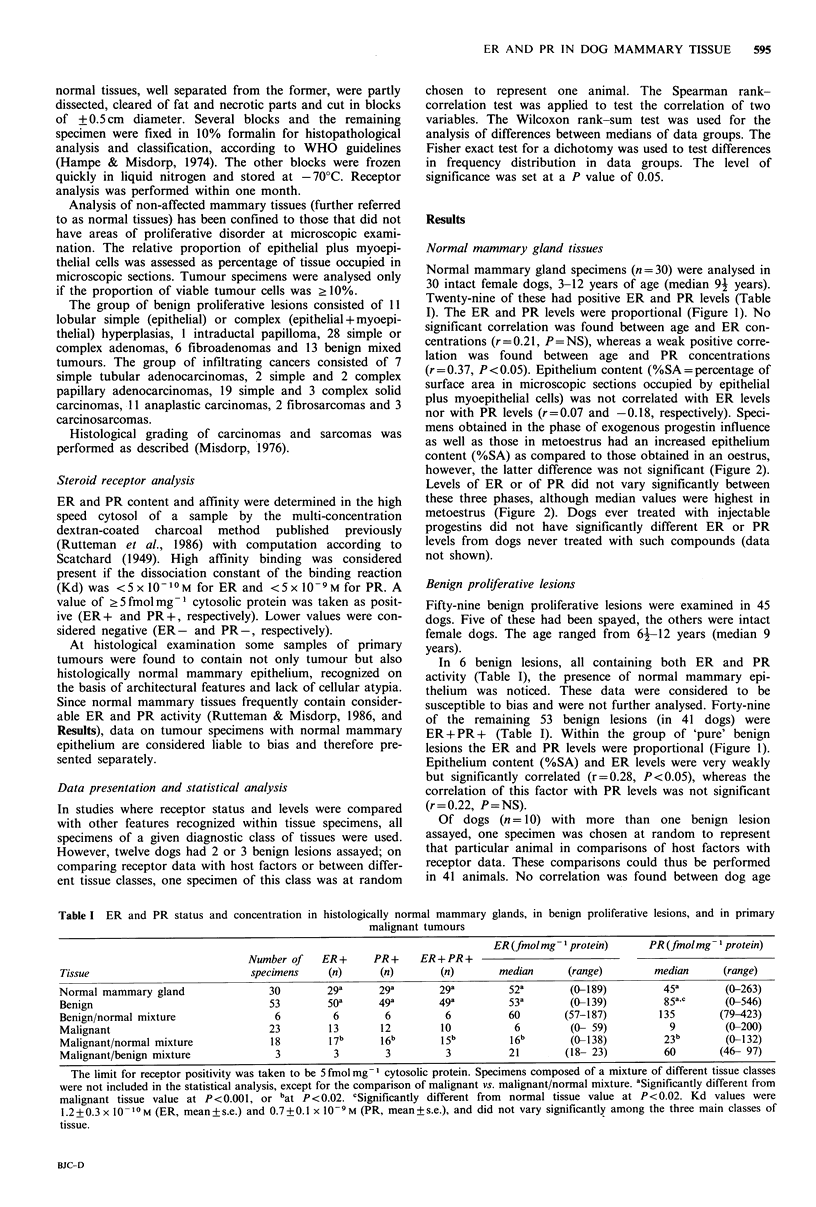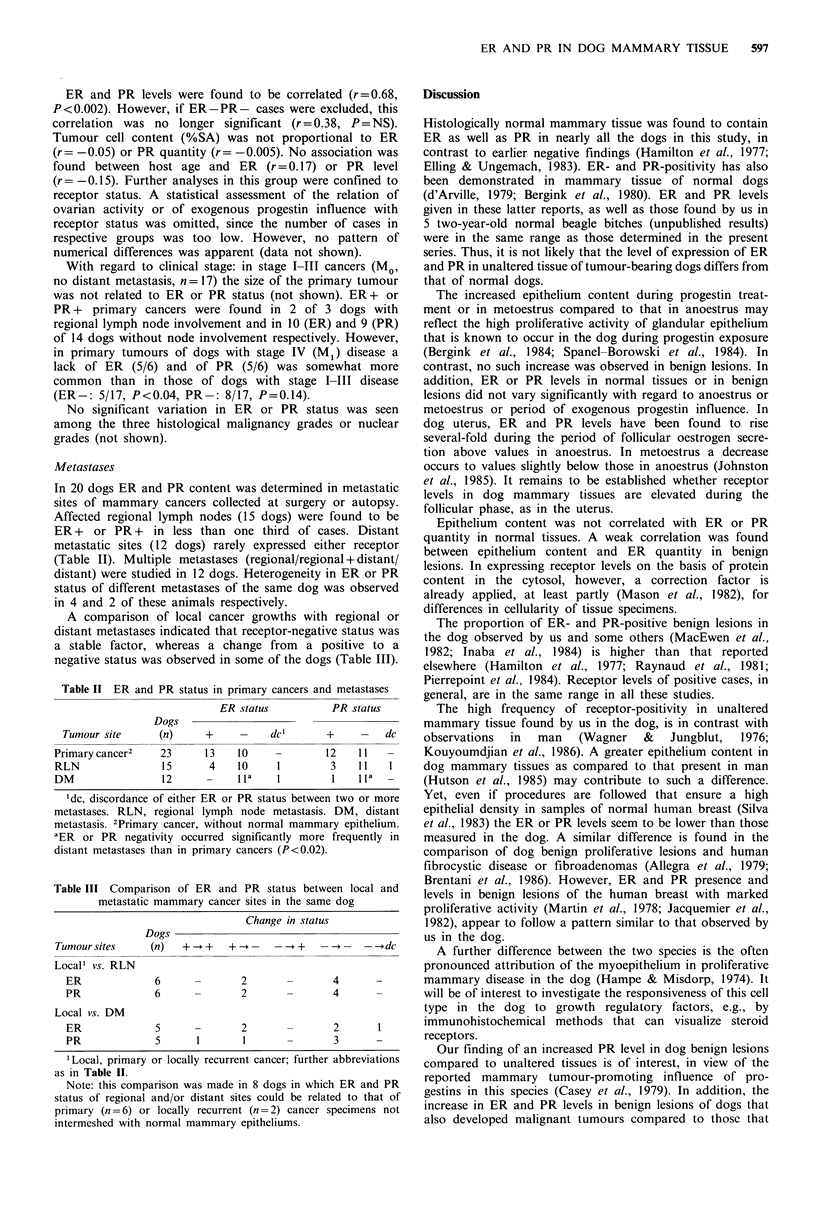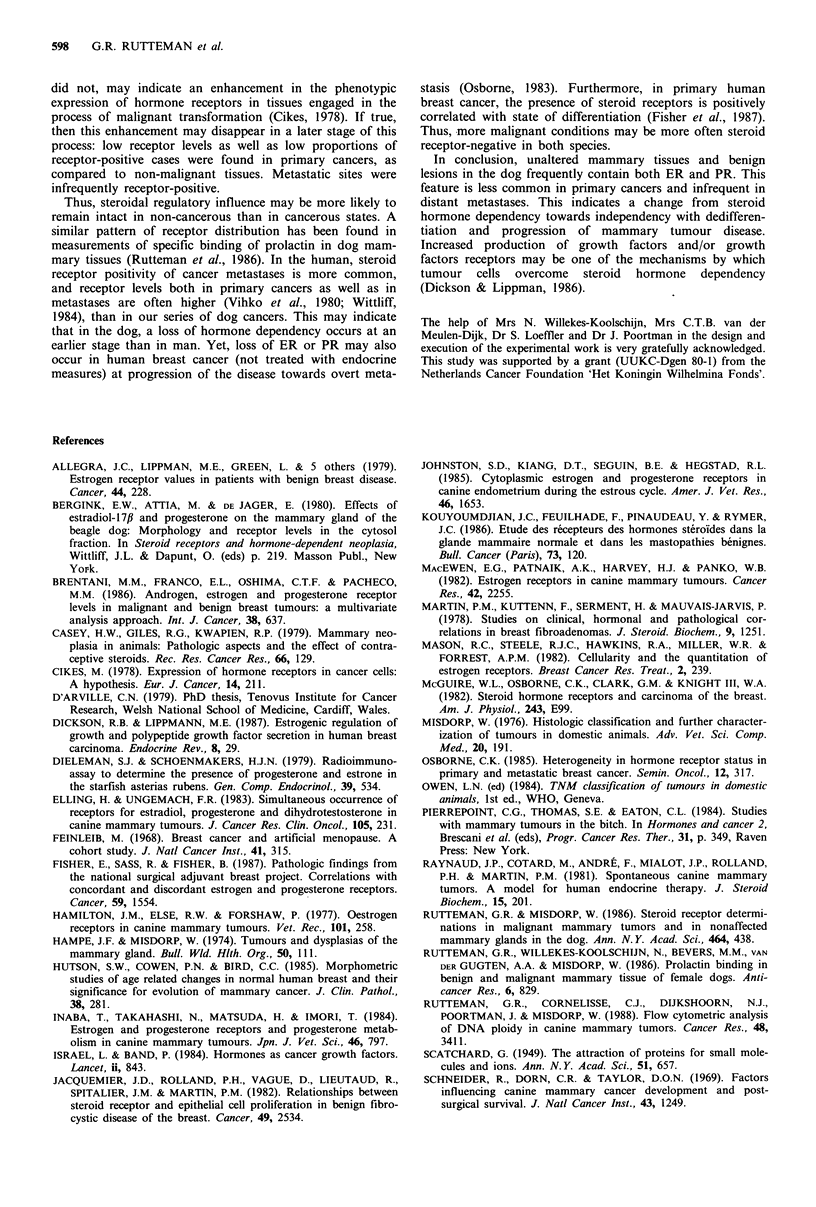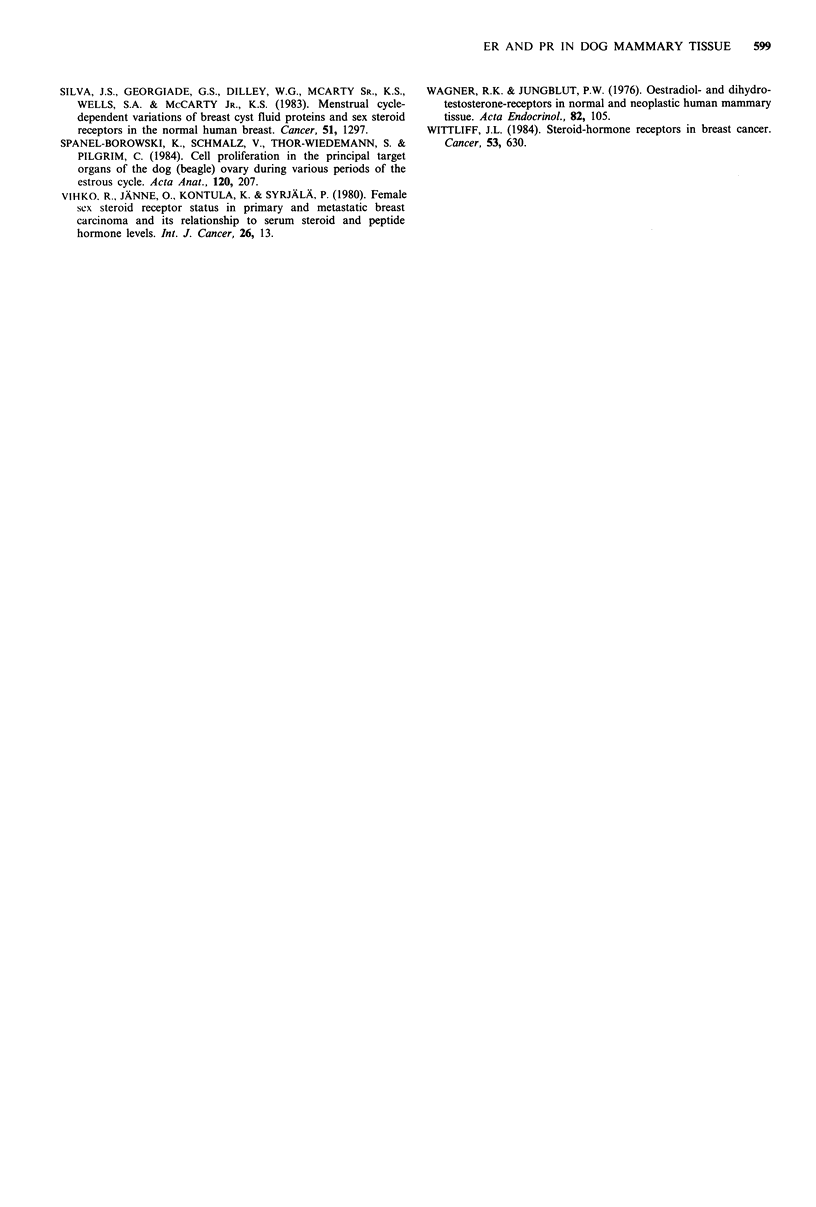Abstract
Oestrogen (ER) and progestin receptors (PR) were measured in cytosols from histologically normal mammary tissues (n = 30), and in benign (n = 59) and malignant mammary lesions (n = 49) from female dogs. Receptor levels greater than or equal to 5 fmol mg-1 protein were considered positive. The presence of histologically normal mammary epithelium within specimens of primary tumours was noticed as a factor that may cause false-positive receptor results. Receptor levels in non-malignant tissues, and the receptor status of primary cancers did not vary significantly with regard to the phase of oestrous cycle (anoestrus/metoestrus) or the influence of exogenous progestins. ER- or PR-positivity was more frequent and levels of both receptors were higher in 'normal' tissues and in benign lesions than in primary cancers (P less than 0.001). ER and PR levels were higher in benign lesions of dogs also developing malignant mammary tumours than in benign lesions of dogs that did not (P less than 0.02 and P less than 0.05, respectively). Regional and distant cancer metastases were frequently receptor-negative. In some dogs heterogeneity of receptor status was found between different sites of the same cancer. These findings indicate that in non-malignant mammary tissues of adult female dogs expression of the genes encoding ER and PR is common. In malignant tumours this property may become lost, in particular in advanced states of disease.
Full text
PDF





Selected References
These references are in PubMed. This may not be the complete list of references from this article.
- Allegra J. C., Lippman M. E., Green L., Barlock A., Simon R., Thompson E. B., Huff K. K., Griffin W. Estrogen receptor values in patients with benign breast disease. Cancer. 1979 Jul;44(1):228–231. doi: 10.1002/1097-0142(197907)44:1<228::aid-cncr2820440137>3.0.co;2-0. [DOI] [PubMed] [Google Scholar]
- Brentani M. M., Franco E. L., Oshima C. T., Pacheco M. M. Androgen, estrogen, and progesterone receptor levels in malignant and benign breast tumors: a multivariate analysis approach. Int J Cancer. 1986 Nov 15;38(5):637–642. doi: 10.1002/ijc.2910380504. [DOI] [PubMed] [Google Scholar]
- Casey H. W., Giles R. C., Kwapien R. P. Mammary neoplasia in animals: pathologic aspects and the effects of contraceptive steroids. Recent Results Cancer Res. 1979;66:129–160. doi: 10.1007/978-3-642-81267-5_4. [DOI] [PubMed] [Google Scholar]
- Cikes M. Expression of hormone receptors in cancer cells: a hypothesis. Eur J Cancer. 1978 Mar;14(3):211–215. doi: 10.1016/0014-2964(78)90184-6. [DOI] [PubMed] [Google Scholar]
- Dickson R. B., Lippman M. E. Estrogenic regulation of growth and polypeptide growth factor secretion in human breast carcinoma. Endocr Rev. 1987 Feb;8(1):29–43. doi: 10.1210/edrv-8-1-29. [DOI] [PubMed] [Google Scholar]
- Dieleman S. J., Schoenmakers H. J. Radioimmunoassays to determine the presence of progesterone and estrone in the starfish Asterias rubens. Gen Comp Endocrinol. 1979 Dec;39(4):534–542. doi: 10.1016/0016-6480(79)90242-9. [DOI] [PubMed] [Google Scholar]
- Elling H., Ungemach F. R. Simultaneous occurrence of receptors for estradiol, progesterone, and dihydrotestosterone in canine mammary tumors. J Cancer Res Clin Oncol. 1983;105(3):231–237. doi: 10.1007/BF00395750. [DOI] [PubMed] [Google Scholar]
- Feinleib M. Breast cancer and artificial menopause: a cohort study. J Natl Cancer Inst. 1968 Aug;41(2):315–329. [PubMed] [Google Scholar]
- Fisher E. R., Sass R., Fisher B. Pathologic findings from the national surgical adjuvant breast project. Correlations with concordant and discordant estrogen and progesterone receptors. Cancer. 1987 May 1;59(9):1554–1559. doi: 10.1002/1097-0142(19870501)59:9<1554::aid-cncr2820590904>3.0.co;2-b. [DOI] [PubMed] [Google Scholar]
- Hamilton J. M., Else R. W., Forshaw P. Oestrogen receptors in canine mammary tumours. Vet Rec. 1977 Sep 24;101(13):258–260. doi: 10.1136/vr.101.13.258. [DOI] [PubMed] [Google Scholar]
- Hampe J. F., Misdorp W. Tumours and dysplasias of the mammary gland. Bull World Health Organ. 1974;50(1-2):111–133. [PMC free article] [PubMed] [Google Scholar]
- Hutson S. W., Cowen P. N., Bird C. C. Morphometric studies of age related changes in normal human breast and their significance for evolution of mammary cancer. J Clin Pathol. 1985 Mar;38(3):281–287. doi: 10.1136/jcp.38.3.281. [DOI] [PMC free article] [PubMed] [Google Scholar]
- Inaba T., Takahashi N., Matsuda H., Imori T. Estrogen and progesterone receptors and progesterone metabolism in canine mammary tumours. Nihon Juigaku Zasshi. 1984 Dec;46(6):797–803. doi: 10.1292/jvms1939.46.797. [DOI] [PubMed] [Google Scholar]
- Israel L., Band P. Hormones as cancer growth factors. Lancet. 1984 Oct 13;2(8407):843–844. doi: 10.1016/s0140-6736(84)90876-6. [DOI] [PubMed] [Google Scholar]
- Jacquemier J. D., Rolland P. H., Vague D., Lieutaud R., Spitalier J. M., Martin P. M. Relationships between steroid receptor and epithelial cell proliferation in benign fibrocystic disease of the breast. Cancer. 1982 Jun 15;49(12):2534–2536. doi: 10.1002/1097-0142(19820615)49:12<2534::aid-cncr2820491221>3.0.co;2-j. [DOI] [PubMed] [Google Scholar]
- Johnston S. D., Kiang D. T., Seguin B. E., Hegstad R. L. Cytoplasmic estrogen and progesterone receptors in canine endometrium during the estrous cycle. Am J Vet Res. 1985 Aug;46(8):1653–1658. [PubMed] [Google Scholar]
- Kouyoumdjian J. C., Feuilhade F., Pinaudeau Y., Rymer J. C. Etude des récepteurs des hormones stéroïdes dans la glande mammaire normale et dans les mastopathies bénignes. Bull Cancer. 1986;73(2):120–123. [PubMed] [Google Scholar]
- MacEwen E. G., Patnaik A. K., Harvey H. J., Panko W. B. Estrogen receptors in canine mammary tumors. Cancer Res. 1982 Jun;42(6):2255–2259. [PubMed] [Google Scholar]
- Martin P. M., Kuttenn F., Serment H., Mauvais-Jarvis P. Studies on clinical, hormonal and pathological correlations in breast fibroadenomas. J Steroid Biochem. 1978 Dec;9(12):1251–1255. doi: 10.1016/0022-4731(78)90021-3. [DOI] [PubMed] [Google Scholar]
- Mason R. C., Steele R. J., Hawkins R. A., Miller W. R., Forrest A. P. Cellularity and the quantitation of estrogen receptors. Breast Cancer Res Treat. 1982;2(3):239–242. doi: 10.1007/BF01806936. [DOI] [PubMed] [Google Scholar]
- Misdorp W. Histologic classification and further characterization of tumors in domestic animals. Adv Vet Sci Comp Med. 1976;20:191–221. [PubMed] [Google Scholar]
- Osborne C. K. Heterogeneity in hormone receptor status in primary and metastatic breast cancer. Semin Oncol. 1985 Sep;12(3):317–326. [PubMed] [Google Scholar]
- Raynaud J. P., Cotard M., André F., Mialot J. P., Rolland P. H., Martin P. M. Spontaneous canine mammary tumour: a model for human endocrine therapy? J Steroid Biochem. 1981 Dec;15:201–207. doi: 10.1016/0022-4731(81)90276-4. [DOI] [PubMed] [Google Scholar]
- Rutteman G. R., Cornelisse C. J., Dijkshoorn N. J., Poortman J., Misdorp W. Flow cytometric analysis of DNA ploidy in canine mammary tumors. Cancer Res. 1988 Jun 15;48(12):3411–3417. [PubMed] [Google Scholar]
- Rutteman G. R., Willekes-Koolschijn N., Bevers M. M., Van der Gugten A. A., Misdorp W. Prolactin binding in benign and malignant mammary tissue of female dogs. Anticancer Res. 1986 Jul-Aug;6(4):829–835. [PubMed] [Google Scholar]
- Schneider R., Dorn C. R., Taylor D. O. Factors influencing canine mammary cancer development and postsurgical survival. J Natl Cancer Inst. 1969 Dec;43(6):1249–1261. [PubMed] [Google Scholar]
- Silva J. S., Georgiade G. S., Dilley W. G., McCarty K. S., Sr, Wells S. A., Jr, McCarty K. S., Jr Menstrual cycle-dependent variations of breast cyst fluid proteins and sex steroid receptors in the normal human breast. Cancer. 1983 Apr 1;51(7):1297–1302. doi: 10.1002/1097-0142(19830401)51:7<1297::aid-cncr2820510720>3.0.co;2-z. [DOI] [PubMed] [Google Scholar]
- Spanel-Borowski K., Schmalz V., Thor-Wiedemann S., Pilgrim C. Cell proliferation in the principal target organs of the dog (beagle) ovary during various periods of the estrous cycle. Acta Anat (Basel) 1984;120(4):207–213. doi: 10.1159/000145922. [DOI] [PubMed] [Google Scholar]
- Vihko R., Jänne O., Kontula K., Syrjälä P. Female sex steroid receptor status in primary and metastatic breast carcinoma and its relationship to serum steroid peptide hormone levels. Int J Cancer. 1980 Jul 15;26(1):13–21. doi: 10.1002/ijc.2910260104. [DOI] [PubMed] [Google Scholar]
- Wagner R. K., Jungblut P. W. Oestradiol- and dihydrotestosterone receptors in normal and neoplastic human mammary tissue. Acta Endocrinol (Copenh) 1976 May;82(1):105–120. doi: 10.1530/acta.0.0820105. [DOI] [PubMed] [Google Scholar]
- Wittliff J. L. Steroid-hormone receptors in breast cancer. Cancer. 1984 Feb 1;53(3 Suppl):630–643. doi: 10.1002/1097-0142(19840201)53:3+<630::aid-cncr2820531308>3.0.co;2-3. [DOI] [PubMed] [Google Scholar]


